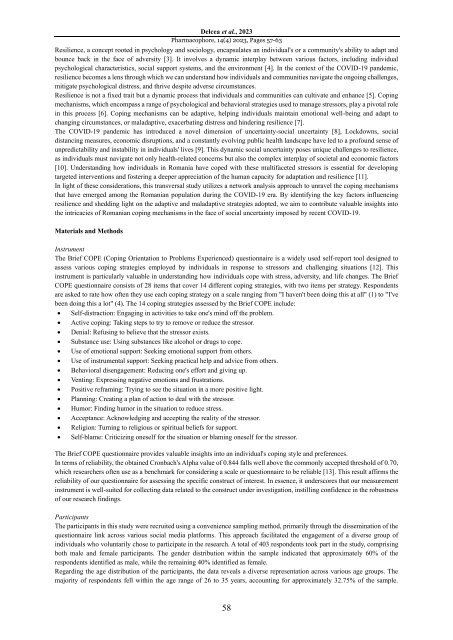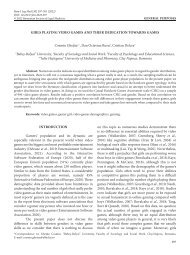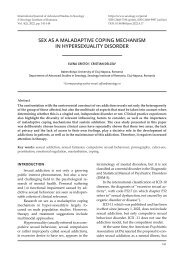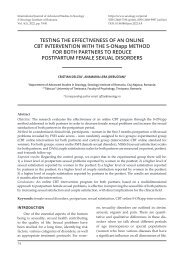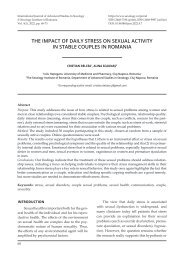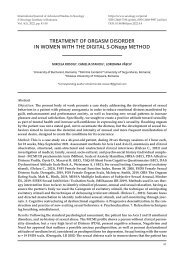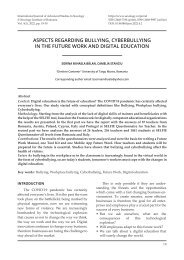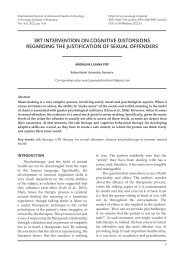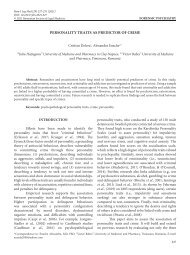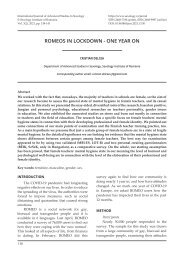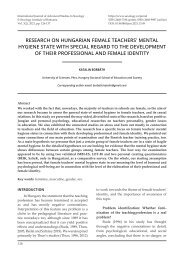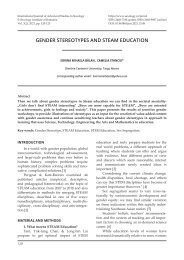A Network Analysis Approach to Romanian Resilience - Coping Mechanisms in the Covid-19 Era
The COVID-19 pandemic has posed unprecedented challenges to individuals worldwide, demanding the rapid development and utilization of coping mechanisms to navigate the recurring waves of uncertainty and disruption. Coping mechanisms are mediated by personality traits, cognitive schemes and developed perceptions. They are activated in states of stress, danger or events such as the COVID-19 period. Our study employing a network analysis approach sheds light on the coping mechanisms utilized during the recurring periods of the COVID era among a convenience sampling of 403 respondents in Romania. The findings highlight that substance use emerges as the most destabilizing factor within the pandemic resilience network, while the use of instrumental support exhibits the highest expected influence, offering valuable insights into the adaptive and maladaptive strategies that shape the Romanian population's resilience during these challenging times.They highlight the complex interplay of coping strategies and the need for tailored interventions that consider the influential positions and susceptibilities of specific coping mechanisms within the context of recurring COVID-19 waves.
The COVID-19 pandemic has posed unprecedented challenges to individuals worldwide, demanding the rapid development and utilization of coping mechanisms to navigate the recurring waves of uncertainty and disruption. Coping mechanisms are mediated by personality traits, cognitive schemes and developed perceptions. They are activated in states of stress, danger or events such as the COVID-19 period. Our study employing a network analysis approach sheds light on the coping mechanisms utilized during the recurring periods of the COVID era among a convenience sampling of 403 respondents in Romania. The findings highlight that substance use emerges as the most destabilizing factor within the pandemic resilience network, while the use of instrumental support exhibits the highest expected influence, offering valuable insights into the adaptive and maladaptive strategies that shape the Romanian population's resilience during these challenging times.They highlight the complex interplay of coping strategies and the need for tailored interventions that consider the influential positions and susceptibilities of specific coping mechanisms within the context of recurring COVID-19 waves.
Create successful ePaper yourself
Turn your PDF publications into a flip-book with our unique Google optimized e-Paper software.
Delcea et al., 2023<br />
Pharmacophore, 14(4) 2023, Pages 57-63<br />
<strong>Resilience</strong>, a concept rooted <strong>in</strong> psychology and sociology, encapsulates an <strong>in</strong>dividual's or a community's ability <strong>to</strong> adapt and<br />
bounce back <strong>in</strong> <strong>the</strong> face of adversity [3]. It <strong>in</strong>volves a dynamic <strong>in</strong>terplay between various fac<strong>to</strong>rs, <strong>in</strong>clud<strong>in</strong>g <strong>in</strong>dividual<br />
psychological characteristics, social support systems, and <strong>the</strong> environment [4]. In <strong>the</strong> context of <strong>the</strong> COVID-<strong>19</strong> pandemic,<br />
resilience becomes a lens through which we can understand how <strong>in</strong>dividuals and communities navigate <strong>the</strong> ongo<strong>in</strong>g challenges,<br />
mitigate psychological distress, and thrive despite adverse circumstances.<br />
<strong>Resilience</strong> is not a fixed trait but a dynamic process that <strong>in</strong>dividuals and communities can cultivate and enhance [5]. <strong>Cop<strong>in</strong>g</strong><br />
mechanisms, which encompass a range of psychological and behavioral strategies used <strong>to</strong> manage stressors, play a pivotal role<br />
<strong>in</strong> this process [6]. <strong>Cop<strong>in</strong>g</strong> mechanisms can be adaptive, help<strong>in</strong>g <strong>in</strong>dividuals ma<strong>in</strong>ta<strong>in</strong> emotional well-be<strong>in</strong>g and adapt <strong>to</strong><br />
chang<strong>in</strong>g circumstances, or maladaptive, exacerbat<strong>in</strong>g distress and h<strong>in</strong>der<strong>in</strong>g resilience [7].<br />
The COVID-<strong>19</strong> pandemic has <strong>in</strong>troduced a novel dimension of uncerta<strong>in</strong>ty-social uncerta<strong>in</strong>ty [8], Lockdowns, social<br />
distanc<strong>in</strong>g measures, economic disruptions, and a constantly evolv<strong>in</strong>g public health landscape have led <strong>to</strong> a profound sense of<br />
unpredictability and <strong>in</strong>stability <strong>in</strong> <strong>in</strong>dividuals' lives [9]. This dynamic social uncerta<strong>in</strong>ty poses unique challenges <strong>to</strong> resilience,<br />
as <strong>in</strong>dividuals must navigate not only health-related concerns but also <strong>the</strong> complex <strong>in</strong>terplay of societal and economic fac<strong>to</strong>rs<br />
[10]. Understand<strong>in</strong>g how <strong>in</strong>dividuals <strong>in</strong> Romania have coped with <strong>the</strong>se multifaceted stressors is essential for develop<strong>in</strong>g<br />
targeted <strong>in</strong>terventions and foster<strong>in</strong>g a deeper appreciation of <strong>the</strong> human capacity for adaptation and resilience [11].<br />
In light of <strong>the</strong>se considerations, this transversal study utilizes a network analysis approach <strong>to</strong> unravel <strong>the</strong> cop<strong>in</strong>g mechanisms<br />
that have emerged among <strong>the</strong> <strong>Romanian</strong> population dur<strong>in</strong>g <strong>the</strong> COVID-<strong>19</strong> era. By identify<strong>in</strong>g <strong>the</strong> key fac<strong>to</strong>rs <strong>in</strong>fluenc<strong>in</strong>g<br />
resilience and shedd<strong>in</strong>g light on <strong>the</strong> adaptive and maladaptive strategies adopted, we aim <strong>to</strong> contribute valuable <strong>in</strong>sights <strong>in</strong><strong>to</strong><br />
<strong>the</strong> <strong>in</strong>tricacies of <strong>Romanian</strong> cop<strong>in</strong>g mechanisms <strong>in</strong> <strong>the</strong> face of social uncerta<strong>in</strong>ty imposed by recent COVID-<strong>19</strong>.<br />
Materials and Methods<br />
Instrument<br />
The Brief COPE (<strong>Cop<strong>in</strong>g</strong> Orientation <strong>to</strong> Problems Experienced) questionnaire is a widely used self-report <strong>to</strong>ol designed <strong>to</strong><br />
assess various cop<strong>in</strong>g strategies employed by <strong>in</strong>dividuals <strong>in</strong> response <strong>to</strong> stressors and challeng<strong>in</strong>g situations [12]. This<br />
<strong>in</strong>strument is particularly valuable <strong>in</strong> understand<strong>in</strong>g how <strong>in</strong>dividuals cope with stress, adversity, and life changes. The Brief<br />
COPE questionnaire consists of 28 items that cover 14 different cop<strong>in</strong>g strategies, with two items per strategy. Respondents<br />
are asked <strong>to</strong> rate how often <strong>the</strong>y use each cop<strong>in</strong>g strategy on a scale rang<strong>in</strong>g from "I haven't been do<strong>in</strong>g this at all" (1) <strong>to</strong> "I've<br />
been do<strong>in</strong>g this a lot" (4). The 14 cop<strong>in</strong>g strategies assessed by <strong>the</strong> Brief COPE <strong>in</strong>clude:<br />
• Self-distraction: Engag<strong>in</strong>g <strong>in</strong> activities <strong>to</strong> take one's m<strong>in</strong>d off <strong>the</strong> problem.<br />
• Active cop<strong>in</strong>g: Tak<strong>in</strong>g steps <strong>to</strong> try <strong>to</strong> remove or reduce <strong>the</strong> stressor.<br />
• Denial: Refus<strong>in</strong>g <strong>to</strong> believe that <strong>the</strong> stressor exists.<br />
• Substance use: Us<strong>in</strong>g substances like alcohol or drugs <strong>to</strong> cope.<br />
• Use of emotional support: Seek<strong>in</strong>g emotional support from o<strong>the</strong>rs.<br />
• Use of <strong>in</strong>strumental support: Seek<strong>in</strong>g practical help and advice from o<strong>the</strong>rs.<br />
• Behavioral disengagement: Reduc<strong>in</strong>g one's effort and giv<strong>in</strong>g up.<br />
• Vent<strong>in</strong>g: Express<strong>in</strong>g negative emotions and frustrations.<br />
• Positive refram<strong>in</strong>g: Try<strong>in</strong>g <strong>to</strong> see <strong>the</strong> situation <strong>in</strong> a more positive light.<br />
• Plann<strong>in</strong>g: Creat<strong>in</strong>g a plan of action <strong>to</strong> deal with <strong>the</strong> stressor.<br />
• Humor: F<strong>in</strong>d<strong>in</strong>g humor <strong>in</strong> <strong>the</strong> situation <strong>to</strong> reduce stress.<br />
• Acceptance: Acknowledg<strong>in</strong>g and accept<strong>in</strong>g <strong>the</strong> reality of <strong>the</strong> stressor.<br />
• Religion: Turn<strong>in</strong>g <strong>to</strong> religious or spiritual beliefs for support.<br />
• Self-blame: Criticiz<strong>in</strong>g oneself for <strong>the</strong> situation or blam<strong>in</strong>g oneself for <strong>the</strong> stressor.<br />
The Brief COPE questionnaire provides valuable <strong>in</strong>sights <strong>in</strong><strong>to</strong> an <strong>in</strong>dividual's cop<strong>in</strong>g style and preferences.<br />
In terms of reliability, <strong>the</strong> obta<strong>in</strong>ed Cronbach's Alpha value of 0.844 falls well above <strong>the</strong> commonly accepted threshold of 0.70,<br />
which researchers often use as a benchmark for consider<strong>in</strong>g a scale or questionnaire <strong>to</strong> be reliable [13]. This result affirms <strong>the</strong><br />
reliability of our questionnaire for assess<strong>in</strong>g <strong>the</strong> specific construct of <strong>in</strong>terest. In essence, it underscores that our measurement<br />
<strong>in</strong>strument is well-suited for collect<strong>in</strong>g data related <strong>to</strong> <strong>the</strong> construct under <strong>in</strong>vestigation, <strong>in</strong>still<strong>in</strong>g confidence <strong>in</strong> <strong>the</strong> robustness<br />
of our research f<strong>in</strong>d<strong>in</strong>gs.<br />
Participants<br />
The participants <strong>in</strong> this study were recruited us<strong>in</strong>g a convenience sampl<strong>in</strong>g method, primarily through <strong>the</strong> dissem<strong>in</strong>ation of <strong>the</strong><br />
questionnaire l<strong>in</strong>k across various social media platforms. This approach facilitated <strong>the</strong> engagement of a diverse group of<br />
<strong>in</strong>dividuals who voluntarily chose <strong>to</strong> participate <strong>in</strong> <strong>the</strong> research. A <strong>to</strong>tal of 403 respondents <strong>to</strong>ok part <strong>in</strong> <strong>the</strong> study, compris<strong>in</strong>g<br />
both male and female participants. The gender distribution with<strong>in</strong> <strong>the</strong> sample <strong>in</strong>dicated that approximately 60% of <strong>the</strong><br />
respondents identified as male, while <strong>the</strong> rema<strong>in</strong><strong>in</strong>g 40% identified as female.<br />
Regard<strong>in</strong>g <strong>the</strong> age distribution of <strong>the</strong> participants, <strong>the</strong> data reveals a diverse representation across various age groups. The<br />
majority of respondents fell with<strong>in</strong> <strong>the</strong> age range of 26 <strong>to</strong> 35 years, account<strong>in</strong>g for approximately 32.75% of <strong>the</strong> sample.<br />
58


